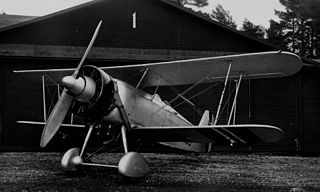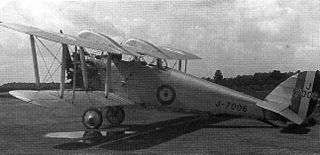
Svenska Aero Jaktfalken ("Gyrfalcon") was a Swedish biplane fighter aircraft, constructed in the late 1920s. The aircraft was first manufactured by Svenska Aero and later by AB Svenska Järnvägsverkstädernas Aeroplanavdelning (ASJA).

The Fokker D.XVI was a sesquiplane fighter aircraft developed in the Netherlands in the late 1920s.

The Heinkel HD 24 was a training seaplane developed in Germany in the late 1920s. It was a conventional single-bay biplane with equal-span, staggered wings. The fuselage was braced to both the upper and lower wings with a number of struts on its sides, in addition to the normal cabane struts. The pilot and instructor sat in tandem, open cockpits, and the undercarriage consisted of twin pontoons, although this could be readily exchanged for wheels or skis.

The de Havilland DH.42 Dormouse and its two variants the de Havilland DH.42A Dingo I and II were two-seat single-engined biplanes designed for fighter-reconnaissance and army cooperation roles. They did not achieve production.
The Handley Page H.P.51 was a monoplane conversion of the earlier, unsuccessful biplane bomber-transport aircraft, the Handley Page H.P.43. The Air Ministry ordered the production variant off the drawing board as the Handley Page H.P.54 Harrow bomber.
The Parnall Parasol was an experimental parasol winged aircraft design to measure the aerodynamic forces on wings in flight. Two were built and flown in the early 1930s in the UK.

The Junkers T 19, originally known as the J 19, was a single-engined parasol winged all-metal 2/3-seat aircraft built in Germany in the early 1920s for training and touring. Its construction was too expensive for commercial success and only three were built, one later finding use as an engine test-bed.

The Morane-Saulnier MS.180 is a single engine, single parasol wing aerobatic trainer designed in France in 1929. About seventeen were produced and used in French flying clubs, some surviving World War II and one remaining in use at a club until the 1970s. Before World War II, some were used by Spanish Republican forces to train pilots in the Spanish Civil War. Two MS.181s are still flying.

The Pander E was the first indigenous Dutch training aircraft, used by clubs and also privately owned. A two-seat, single-engine biplane, 17 were built in the Netherlands from 1926 with engines of increasing power.
The SEA.1 was a Belgian, multi-purpose, light twin engine monoplane flown in 1936. Only one was built; it was later converted into a single engine aircraft and used by the military.
The Morane-Saulnier MS.300 and MS.301 were French parasol wing introductory trainer aircraft, first flown in 1930. They differed only in engine type. Neither reached production but were developed into two similar trainers, the MS.230 and MS.315, which were made in large numbers.

The Raab-Katzenstein RK.9 Grasmücke (Hedge-sparrow) was a 1920s German two-seat touring, advertising and training biplane. It was one of many designs from several countries aiming to provide low cost flying and was quite successful, with about twenty built.
The Morane-Saulnier MS.152 was a French multi-purpose aircraft built in 1928. It did not go into production.

The Medwecki and Nowakowski M.N.5 was an economical Polish trainer aircraft initially aimed at the club market, though there was also some military interest. It performed well but lacked a constructor after Samolot became insolvent in 1930, so only one was completed.
The Stiles Dragon Fly was an American two seat monoplane aircraft of the late 1920s. It was aimed at private and club owners. Significant production was planned but few were built.

The Gee Bee Model A was an American two-seat open cockpit single-bay biplane developed by the Granville Brothers that first flew in 1929.

The Wallace Touroplane was a late 1920s U.S. three seat, high wing cabin monoplane. About 20 were built.
The Watkins Skylark was an American low-wing, cantilever two-seater designed for private and club use. A large anticipated production run in 1930 ended early when the company collapsed in the Great Depression, with only five or six registered.

The Zenith Z-6 is a single engine biplane U.S. airliner built in the late 1920s. Its cabin, in the fuselage immediately behind its radial engine, holds five or six passengers depending on engine power. It is flown from an open cockpit further aft. Nine were completed and one has been restored to flight.
The Stampe et Vertongen ST.26 was a 1930s Belgian military blind- and night-flying trainer aircraft.













